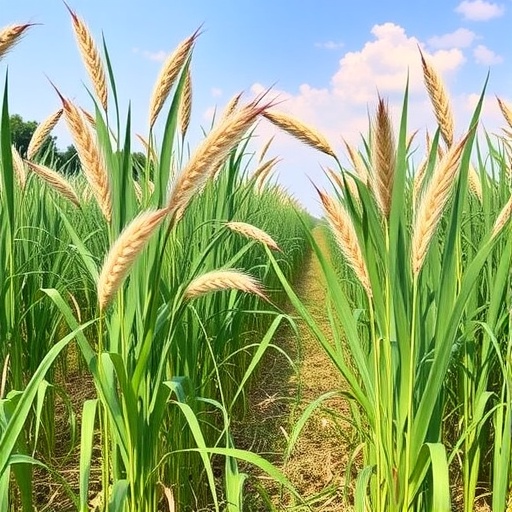In the quest to better understand the carbon sequestration potential of bioenergy crops, recent research has turned the spotlight on Miscanthus × giganteus (M × g), a fast-growing perennial grass that shows promise for sustainable biomass production. Traditional assessments of the carbon uptake and net primary productivity (NPP) of M × g have largely concentrated on the aboveground biomass, primarily because it is the harvestable component. However, this narrow focus overlooks the substantial contributions of belowground structures, such as rhizomes and roots, which are critical to carbon storage in perennial cropping systems. A groundbreaking study from the Center for Advanced Bioenergy and Bioproducts Innovation (CABBI) has now provided a more comprehensive understanding by directly quantifying both aboveground and belowground NPP of mature M × g.
The CABBI-led research represents a meticulous experimental investigation designed to capture the full spectrum of biomass productivity of M × g across several locations and varying nitrogen fertilization regimes. Recognizing the variability imposed by environmental gradients and management practices, the team collected biomass samples from three distinct sites, applying three different nitrogen doses. Sampling was performed at two key points during the growing season to also account for temporal variations in biomass accumulation, allowing for a robust analysis of growth dynamics throughout the crop’s developmental stages.
Measurements revealed striking variability in M × g productivity. Aboveground net primary productivity ranged significantly—from 15.4 to 36.4 megagrams of dry matter per hectare annually—demonstrating how site-specific conditions and fertilizer inputs drive biomass accumulation above soil level. While much focus has previously been on this aboveground yield, the belowground NPP, often sidelined due to technical difficulties in sampling root structures, was confirmed to be non-trivial. It varied from 4.4 to 19.6 megagrams of dry matter per hectare per year, underscoring the substantial belowground carbon storage potential of this grass.
One of the more revealing insights from the study comes from the observed root-to-shoot ratios, which declined with increasing nitrogen fertilizer applications. At zero nitrogen input, the root-to-shoot ratio was approximately 1.9, indicating that root biomass was nearly double that of the shoot biomass. This ratio decreased to 0.89 at the highest nitrogen application rate of 224 kg N per hectare, suggesting that nitrogen availability shifts resource allocation in M × g towards aboveground growth. This has important implications for carbon cycling because allocation patterns impact carbon storage longevity; belowground carbon is generally more stable and less prone to rapid turnover.
Delving deeper into the effects of nitrogen fertilization, the researchers demonstrated that nitrogen application significantly modulated productivity patterns. Elevated nitrogen promoted vigorous aboveground growth, thereby influencing total NPP. Yet, it simultaneously suppressed belowground biomass accumulation, potentially diminishing long-term soil carbon storage. This tradeoff highlights critical management considerations for bioenergy cropping systems seeking to optimize both yield and sustainability goals.
Perhaps most consequentially, the study illuminated that overall variability in mature M × g NPP is predominantly driven by fluctuations in aboveground productivity rather than belowground growth. This finding challenges some previous assumptions that emphasized belowground processes as primary determinants of carbon storage variability in perennial grasses. Instead, site-specific factors and fertilization regimes that enhance aboveground biomass production appear to be key levers influencing total carbon uptake capacity.
These findings have far-reaching significance for agroecosystem modeling efforts. Accurate representation of carbon dynamics in bioenergy crops necessitates integrating nuanced data on both above- and belowground productivity responses to environmental and management controls. The CABBI study fills a critical knowledge gap by providing empirical datasets on biomass partitioning and NPP variability across gradients of nitrogen inputs and site conditions. As modeling frameworks evolve, inclusion of this detailed productivity partitioning will improve predictions of carbon flux and storage, informing climate mitigation strategies.
Moreover, the methodological advances in belowground biomass sampling employed in this research set new standards for future studies. By comparing different methods for rhizome biomass collection and carefully timing harvest cycles, the researchers enhanced the reliability of belowground productivity estimates. This improved measurement fidelity addresses a persistent challenge in perennial crop ecology and paves the way for more precise assessments of soil carbon sequestration potential under perennial bioenergy systems.
The implications extend beyond carbon accounting to broader sustainability objectives. M × g’s ability to sequester carbon both above and below ground bolsters its appeal as a multipurpose crop capable of providing feedstock for renewable energy while concurrently serving as a carbon sink. Understanding the nitrogen-dependent shift in biomass allocation also informs optimization of fertilization practices that balance maximizing yield with preserving soil health and carbon stocks.
In the broader context of climate change mitigation and bioeconomy development, this study contributes vital empirical evidence supporting the deployment of perennial grasses like M × g in sustainable biomass production landscapes. Their dual role in delivering biomass yield and enhancing ecosystem carbon sequestration aligns well with policy frameworks seeking carbon-negative bioenergy solutions. The research further underscores the necessity of field-scale, multi-temporal biomass assessments to capture the complex interactions influencing perennial crop productivity and carbon cycling.
In conclusion, the CABBI study redefines our understanding of productivity in Miscanthus × giganteus by highlighting that aboveground production variability, shaped by nitrogen fertilization and local environment, primarily drives total net primary productivity. This paradigm shift not only enhances carbon budget estimations but also informs best management practices to optimize perennial bioenergy crops for carbon sequestration. Science and policy stakeholders stand to benefit from these insights as they chart pathways toward resilient and climate-smart bioenergy systems.
Subject of Research: Not applicable
Article Title: Aboveground Rather Than Belowground Productivity Drives Variability in Miscanthus × giganteus Net Primary Productivity
News Publication Date: 21-Aug-2025
Web References: http://dx.doi.org/10.1111/gcbb.70072
Method of Research: Experimental study
Keywords: Carbon sequestration, Crop science, Agriculture, Agronomy, Agroecosystems, Crop production, Crop yields, Bioenergy, Carbon capture
Tags: aboveground vs belowground biomassadvanced bioenergy innovation researchcarbon sequestration in bioenergy cropscarbon storage in agricultural systemscomprehensive biomass assessment methodologiesenvironmental gradients in crop productivityMiscanthus × giganteus biomass productivitynet primary productivity in perennial grassesnitrogen fertilization effects on Miscanthusrhizome and root contributions to productivitysustainable biomass production researchtemporal variations in crop growth





